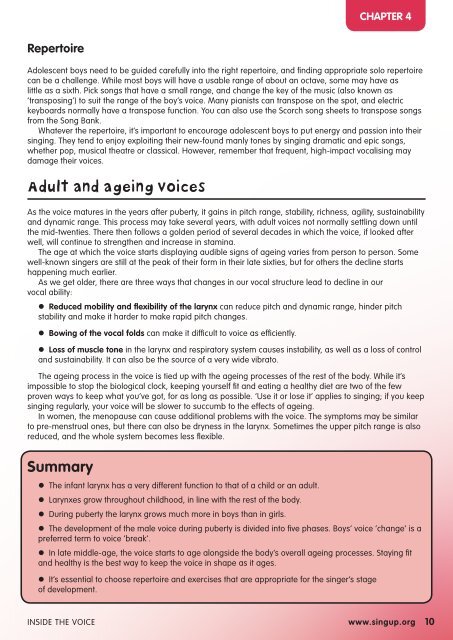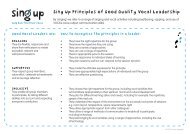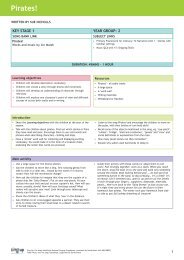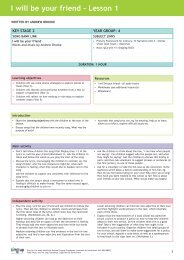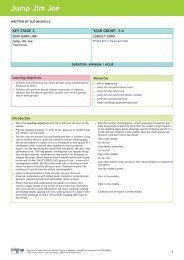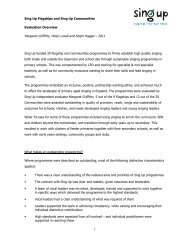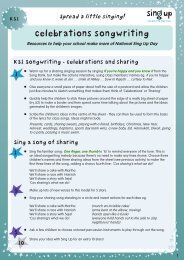Voice development over the lifespan - Sing Up
Voice development over the lifespan - Sing Up
Voice development over the lifespan - Sing Up
You also want an ePaper? Increase the reach of your titles
YUMPU automatically turns print PDFs into web optimized ePapers that Google loves.
CHAPTER 4<br />
Repertoire<br />
Adolescent boys need to be guided carefully into <strong>the</strong> right repertoire, and finding appropriate solo repertoire<br />
can be a challenge. While most boys will have a usable range of about an octave, some may have as<br />
little as a sixth. Pick songs that have a small range, and change <strong>the</strong> key of <strong>the</strong> music (also known as<br />
‘transposing’) to suit <strong>the</strong> range of <strong>the</strong> boy’s voice. Many pianists can transpose on <strong>the</strong> spot, and electric<br />
keyboards normally have a transpose function. You can also use <strong>the</strong> Scorch song sheets to transpose songs<br />
from <strong>the</strong> Song Bank.<br />
Whatever <strong>the</strong> repertoire, it’s important to encourage adolescent boys to put energy and passion into <strong>the</strong>ir<br />
singing. They tend to enjoy exploiting <strong>the</strong>ir new-found manly tones by singing dramatic and epic songs,<br />
whe<strong>the</strong>r pop, musical <strong>the</strong>atre or classical. However, remember that frequent, high-impact vocalising may<br />
damage <strong>the</strong>ir voices.<br />
Adult and ageing voices<br />
As <strong>the</strong> voice matures in <strong>the</strong> years after puberty, it gains in pitch range, stability, richness, agility, sustainability<br />
and dynamic range. This process may take several years, with adult voices not normally settling down until<br />
<strong>the</strong> mid-twenties. There <strong>the</strong>n follows a golden period of several decades in which <strong>the</strong> voice, if looked after<br />
well, will continue to streng<strong>the</strong>n and increase in stamina.<br />
The age at which <strong>the</strong> voice starts displaying audible signs of ageing varies from person to person. Some<br />
well-known singers are still at <strong>the</strong> peak of <strong>the</strong>ir form in <strong>the</strong>ir late sixties, but for o<strong>the</strong>rs <strong>the</strong> decline starts<br />
happening much earlier.<br />
As we get older, <strong>the</strong>re are three ways that changes in our vocal structure lead to decline in our<br />
vocal ability:<br />
• z Reduced mobility and flexibility of <strong>the</strong> larynx can reduce pitch and dynamic range, hinder pitch<br />
stability and make it harder to make rapid pitch changes.<br />
• z Bowing of <strong>the</strong> vocal folds can make it difficult to voice as efficiently.<br />
• z Loss of muscle tone in <strong>the</strong> larynx and respiratory system causes instability, as well as a loss of control<br />
and sustainability. It can also be <strong>the</strong> source of a very wide vibrato.<br />
The ageing process in <strong>the</strong> voice is tied up with <strong>the</strong> ageing processes of <strong>the</strong> rest of <strong>the</strong> body. While it’s<br />
impossible to stop <strong>the</strong> biological clock, keeping yourself fit and eating a healthy diet are two of <strong>the</strong> few<br />
proven ways to keep what you’ve got, for as long as possible. ‘Use it or lose it’ applies to singing; if you keep<br />
singing regularly, your voice will be slower to succumb to <strong>the</strong> effects of ageing.<br />
In women, <strong>the</strong> menopause can cause additional problems with <strong>the</strong> voice. The symptoms may be similar<br />
to pre-menstrual ones, but <strong>the</strong>re can also be dryness in <strong>the</strong> larynx. Sometimes <strong>the</strong> upper pitch range is also<br />
reduced, and <strong>the</strong> whole system becomes less flexible.<br />
Summary<br />
•z The infant larynx has a very different function to that of a child or an adult.<br />
•z Larynxes grow throughout childhood, in line with <strong>the</strong> rest of <strong>the</strong> body.<br />
•z During puberty <strong>the</strong> larynx grows much more in boys than in girls.<br />
•z The <strong>development</strong> of <strong>the</strong> male voice during puberty is divided into five phases. Boys’ voice ‘change’ is a<br />
preferred term to voice ‘break’.<br />
•z In late middle-age, <strong>the</strong> voice starts to age alongside <strong>the</strong> body’s <strong>over</strong>all ageing processes. Staying fit<br />
and healthy is <strong>the</strong> best way to keep <strong>the</strong> voice in shape as it ages.<br />
•z It’s essential to choose repertoire and exercises that are appropriate for <strong>the</strong> singer’s stage<br />
of <strong>development</strong>.<br />
INSIDE THE VOICE www.singup.org 10


